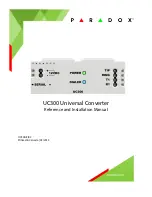
3. Installation
3. Installation
.15.
.14.
3.4 Electrical Connections
The electrical connection of the inverter must follow the steps listed below:
1. Switch the Grid Supply Main Switch (AC) OFF.
2. Switch the DC Isolator OFF.
3. Connect the inverter to the grid.
4. Assemble PV connector and connect to the Inverter.
Inverter design uses PV style quick-connect terminal. The top cover needn't be opened
during DC electrical connection. The labels located the bottom of the inverter are described
below in table 3.1. All electrical connections are suitable for local or national standard.
3.4.1 Grounding
2) Prepare OT terminals: M10.
To effectively protect the inverter, two grounding methods must be performed.
Connect the AC grounding cable (Please refer to section 3.4.3)
Connect the external grounding terminal.
1) Prepare the grounding cable: recommend to use the outdoor copper-core cable. The
grounding wire should be at least half size of the hot wires.
To connect the grounding terminal on the heat sink, please follow the steps below:
A
B
Important:
3) Strip the ground cable insulation to a suitable length.
Figure 3.9 Suitable length
Important:
For multiple inverters in parallel , all inverters should be connected to the
same ground point to eliminate the possibility of a voltage potential existing
between inverter grounds.
B (insulation stripping length) is 2mm~3mm longer than A (OT cable
terminal crimping area) .
Table 3.1 Electrical connection symbols
Parts
Connection
Cable size
Torque
DC terminal
Ground terminal
Grid terminal
RS-485 terminal
RJ45 terminal
COM terminal
PV strings
AC ground
Grid
Communication cable
Communication cable
Wi-Fi/Cellular stick
12-10 AWG
3-1 AWG
2-4/0 AWG
22-12 AWG
Network cable
NA
7.4-8.9 ft.lbs
7.4-14.6 ft.lbs
0.44 ft.lbs
NA
NA
DC surge protection
device
NA
NA
NA
NA
Figure 3.8 Fix the inverter
5.
.
Use screws in the packaging to fix the inverter to the mount bracket
Torque:1.5-2.2 ft.lbs










































